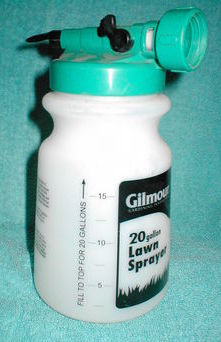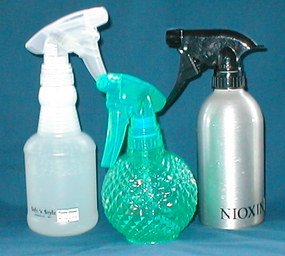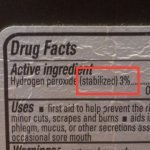Using Hydrogen Peroxide for
Bleaching Skulls and Animal Bones
Using peroxide for bleaching skulls and bones may seem like a radical change of direction. But, peroxide is used to bleach quite a few other things too: wood, paper pulp, teeth (whitening products), yellowed plastic, and hair.
I’ve also heard of using peroxide to bleach piano keys that are discolored, and counter tops that are stained.
So, using peroxide for bleaching skulls and whitening bones may sound different at first, but it’s really not so different if we look at the underlying function. There are lots of uses of hydrogen peroxide that involve bleaching or whitening.
Here is a link to information on using peroxide to clean stained or yellowed plastic.
So, let’s get on to how to use hydrogen peroxide for bleaching skulls and bones…..
I feel in need of a change of pace, so I’m writing this page as a list of Questions and Answers! Here we go:
Questions and Answers about using hydrogen peroxide for beaching skulls and bones
Q: Can I do this if I’m not a taxidermist?
A: Yes, sure you can. You just won’t do it as often as a taxidermist might!
Q: How much peroxide will I need?
A: You’ll need enough to fully cover the skull or bones, in a container. If the container is just barely wide enough for the bones to fit in, you’ll need less peroxide than if you are using a tub that is much wider than the bones. Anyway, find a container to use, and then you need enough hydrogen peroxide to cover up the bones, in the container.
Alternately, you could use just enough 30% or 35% peroxide to paint onto the bones. Some sources talk about doing it this way, either painting peroxide onto the bones, or using a mixture of peroxide and borax powder.
Q: Do I need anything special for the container?
A: No. Most plastic containers will work fine, and so will glass or ceramics. I would avoid metal though, as any scratches or rough areas in the metal may rust, and any free bits of metal will use up some of the oxidation potential of the peroxide.
Q: What peroxide concentration should I use?
A: It depends. I’ve read that 35% hydrogen peroxide is very popular for cleaning bones. This makes sense, since 35% is going to work faster then 3% or 12%. However, lower concentrations, such as 12% will also work. I’ve read about someone using 3% with fine results, too, although I expect this will take longer than using more highly concentrated peroxide. The answer may depend on how white you want the skulls or bones to get, and how quickly.
Q: What type of peroxide should I use?
A: Any grade of peroxide would work to clean skulls and bones. For example, some folks use peroxide that is sold to beauticians to bleach hair. This kind of peroxide is sold by “volume” rather than by the percentage. For example “V40” is 12% hydrogen peroxide.
An advantage of using food grade peroxide is that it has no stabilizers or other additives. However, for cleaning bones, it may not really matter to you whether there are stabilizers in the peroxide or not, at least until you throw it away, at which point any chemical additives go back to the environment.
If you buy 35% hydrogen peroxide, of course you can also water it down, if you want to. You can try using 17% hydrogen peroxide (made with half 35% peroxide and half water), or you can try using 8% hydrogen peroxide (made with one part 35% hydrogen peroxide and 3 parts water).
Q: How can I get the bones into and out of 35% peroxide without touching the peroxide?
A: If you are using 35% hydrogen peroxide it is important not to get it on your skin. Either wear gloves, or use tongs or utensils to get the bones in and out of the peroxide. I would also use gloves or utensils with 12% (V40) peroxide. Use caution about getting anything stronger than 3% hydrogen peroxide on your skin.
Also, please note that if you have any cuts on your hands, even 3% may sting!
(If you should accidentally get 35% peroxide on your skin, immediately flush the skin with lots of water.)
Q: What precautions should I take with this container of peroxide while bleaching skulls and bones?
A: If you are using concentrated peroxide, such as 35%, you need to keep it out of harm’s way. It is fine to have a container of it sitting with bones in it for a day if the container is out of the way of children, animals, and people tripping over it. That’s not a huge restriction, and it may seem like common sense, but the point is that you do need to put it somewhere safe, where there is no risk to you, other people, or animals.
Q: Can I reuse the peroxide after I’m satisfied with the bleaching process?
A: Yes, you can. Every time you use it, some of the oxidation potential of the peroxide will be used up. In fact, the more “work” the peroxide does cleaning a batch of bones, the more if it’s power is used up. So, the solution will get weaker and weaker, the more you use it. You can’t keep using it forever. Also, since it is getting weaker each time you use it, you may find it is taking longer to do its work, or it is not working as well.
Do not put used peroxide into a container with unused peroxide. Doing this can increase the rate at which the unused peroxide breaks down.
Do put used peroxide into a separate container which is clearly labeled DANGER -- HYDROGEN PEROXIDE. You might also want to include the date, the type of peroxide, and how many times you’ve used it.
If you use an opaque (dark) container, the peroxide will break down a bit less while it is stored between uses.
I'd recommend that you use the leftover peroxide right away or dump it out though, rather than store it.
Q: Do I need to clean the bones first?
A: Yes, it is a good idea to get the bones cleaned as well as you can first. This will also result in using up less of the oxidation potential of the peroxide. The more work you leave for the peroxide, the more of the peroxide’s power you use up.
Q: What do I do with the left over hydrogen peroxide when I’m done?
A: Well, you could pour it down the sink, but here are a couple of other options:
- Pour it into the toilet, then don’t flush the toilet for at least an hour or overnight. This will clean the toilet. (This cleans only the area of the toilet that is under the water line.)
- Dilute the peroxide and then give the very diluted mixture to plants – either house plants or plants growing in the garden. When diluting peroxide for plants, it is safer to overdilute it, so use the original strength of the peroxide to calculate, even if you’ve used it many times and it is getting weak. A general dilution ratio for feeding plants is as follows: to 1 gallon of water, add either 1 teaspoon of 35% peroxide OR 2 tablespoons of 12% (v40) peroxide OR ½ cup of 3% peroxide. Here is a chart to help with diluting your leftover peroxide, to feed to your garden or house plants....
- Collect up any yellowed plastic utensils from the kitchen and put them in the tub of peroxide (completely covered). Leave them overnight to whiten.
Now, this is where the type of peroxide that you’ve bought will also matter. I use food grade peroxide as a fertilizer on my plants. I’m not sure about using V40 or beautician’s grades of peroxide on plants. I don’t know enough about the additives in it. And the same goes for the overall environmental effects of the peroxide. When you pour it down the drain – whatever additives are in it are going down the drain and back to the environment. So, from that point of view it is certainly better to use food grade peroxide, as it doesn’t have stabilizers or additives or any other chemicals added to it.
Return from peroxide bleaching skulls and bones to the home page for the site
Subscribe to Hydrogen Peroxide Explorers' Newsletter
Our newsletter will keep you up to date on new pages added, plus some Adventures you can try at home:
No worries! Your email will be used ONLY to send you newsletters.
(Gallon):
(5 pounds):
For some links, I receive ad commissions, at no cost to you. More info here.
Site Search:
Subscribe to our newsletter (free):
Note: Products shown are sold by Amazon. This site does NOT sell hydrogen peroxide.
Do you like this site?

Gardening: attach sprayer to garden hose; use to dilute peroxide and spray on the garden

Spray bottles for peroxide




